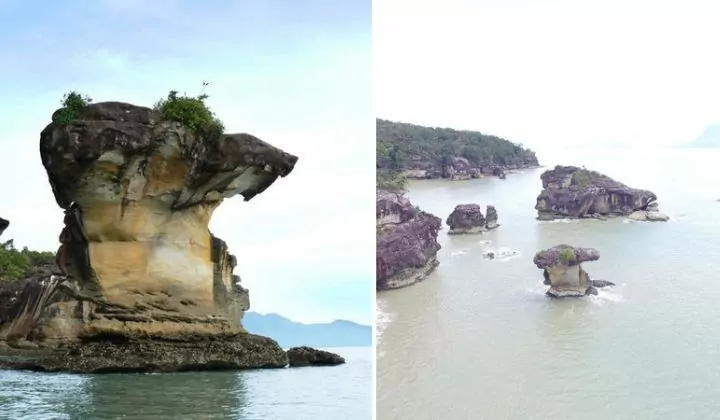Malaysia

BY KERAN
FEBRUARY 14, 2024

Pic Credit: Sarawak Forestry Corporation/.
A travel company known as Borneo Adventure posted a video on their Facebook page yesterday of the iconic rock formation, the Cobra Head Sea Stack at the Bako National Park in Kuching, Sarawak which had collapsed.
The video was taken by their tour guide Paul who said that they have no idea when the rock formation collapsed.
“ …..the Sea Stack is gone, it is gone. We do not know when it has fallen, probably yesterday, today, you never know,” he said in the video.
The Sarawak Forestry Corporation in a statement said that the collapse of the iconic sea stack is believed to have been caused by large waves, the final act of erosion that had been occurring for millions of years.
The sea stack, a geological treasure, was formed from sandstone and has captivated visitors with its unique shapes and sea arches.
CEO Tuan Abang Arabi Abg Aimran expressed shock and sadness upon hearing the news, emphasizing its importance in the local tourism industry, particularly for boat operators at the Bako National Park.
He urged people to admire nature’s beauty and not take for granted its gifts, as nature’s gifts can sometimes be irreplaceable.
“Nature’s gifts sometimes can be restored and sometimes are irreplaceable,” he said in the statement.
Sea stack is a natural occurrence. When we contacted the Sarawak Forestry Corporation, the spokesperson said that the Cobra Head Sea Stack is a million years old and many other such sea stacks formed in the later years at the Bako National Park.
According to an article by Science Struck, sea stacks, towering geological formations in coastal areas, originate from headlands – elevated coastal landforms with sheer drops into the sea. Over time, the relentless mechanical forces of waves and winds gradually erode the softer and weaker parts of headland rocks, leaving behind resilient rock structures.
The formation of sea stacks begins with waves and winds pounding headland rocks, creating a cave. This cave acts as a defence mechanism, and erosion during storms breaks down the rocky interior, forming a hole.
In the final stage, waves and winds break down the rocky arch, forming a sea stack. The destructive forces that shape the sea stack are the same ones that lead to its eventual collapse, highlighting the dynamic interplay between geological processes and natural forces in coastal landscapes.
Sarawak’s Iconic ‘Cobra Head’ Sea Stack Lost To Sea
The collapse of the iconic sea stack is believed to have been caused by large waves.
BY KERAN
FEBRUARY 14, 2024

Pic Credit: Sarawak Forestry Corporation/.
A travel company known as Borneo Adventure posted a video on their Facebook page yesterday of the iconic rock formation, the Cobra Head Sea Stack at the Bako National Park in Kuching, Sarawak which had collapsed.
The video was taken by their tour guide Paul who said that they have no idea when the rock formation collapsed.
“ …..the Sea Stack is gone, it is gone. We do not know when it has fallen, probably yesterday, today, you never know,” he said in the video.
The Sarawak Forestry Corporation in a statement said that the collapse of the iconic sea stack is believed to have been caused by large waves, the final act of erosion that had been occurring for millions of years.
The sea stack, a geological treasure, was formed from sandstone and has captivated visitors with its unique shapes and sea arches.
CEO Tuan Abang Arabi Abg Aimran expressed shock and sadness upon hearing the news, emphasizing its importance in the local tourism industry, particularly for boat operators at the Bako National Park.
He urged people to admire nature’s beauty and not take for granted its gifts, as nature’s gifts can sometimes be irreplaceable.
“Nature’s gifts sometimes can be restored and sometimes are irreplaceable,” he said in the statement.
Sea stack is a natural occurrence. When we contacted the Sarawak Forestry Corporation, the spokesperson said that the Cobra Head Sea Stack is a million years old and many other such sea stacks formed in the later years at the Bako National Park.
According to an article by Science Struck, sea stacks, towering geological formations in coastal areas, originate from headlands – elevated coastal landforms with sheer drops into the sea. Over time, the relentless mechanical forces of waves and winds gradually erode the softer and weaker parts of headland rocks, leaving behind resilient rock structures.
The formation of sea stacks begins with waves and winds pounding headland rocks, creating a cave. This cave acts as a defence mechanism, and erosion during storms breaks down the rocky interior, forming a hole.
In the final stage, waves and winds break down the rocky arch, forming a sea stack. The destructive forces that shape the sea stack are the same ones that lead to its eventual collapse, highlighting the dynamic interplay between geological processes and natural forces in coastal landscapes.
